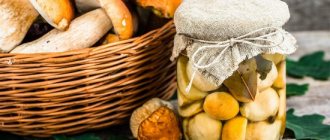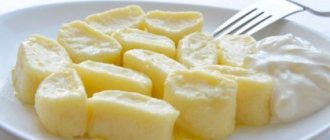Mushrooms are an incredibly healthy product, enriched with minerals and protein. Forest gifts can be consumed as an independent dish, as well as prepared as snacks, soups, salads, sauces, and winter twists. There is a misconception that frequent consumption of mushroom fruits can lead to weight gain, but this information has nothing to do with reality. Today we will look at the calorie content of oyster mushrooms, since this particular mushroom is considered the most affordable, aromatic and tasty, which may well create competition for the noble royal boletus.
Fresh
There are many species of this mushroom found in the wild, but only some of them are suitable for consumption - oyster mushroom (oyster mushroom), royal oyster mushroom (eringa mushroom), elm mushroom (elm mushroom) and others like that. In terms of beneficial properties and nutritional value, all of them have no equal not only among mushrooms, but also among most other products of plant origin. As a rich source of high-quality protein with minimal calorie content, oyster mushrooms are an indispensable component of any diet for weight loss. As a rule, with a limited diet, it is difficult to reach the daily protein requirement, since its main supplier, meat, is too high in calories. The introduction of such a useful component as oyster mushrooms into the menu helps solve this problem. They are especially valued in vegetarianism, since their chemical composition is very close to meat products.
Important! The unique qualities of oyster mushrooms when consumed during weight loss are that, with a very low calorie content, they satisfy hunger very well and help maintain a feeling of fullness for a long time. In addition to this, these mushrooms are rich in enzymes that actively break down fats.
Another advantage is their absolute safety, since, unlike most other representatives of this category, these do not accumulate harmful substances in the environment. The pulp of such mushrooms does not contain heavy metal salts, pesticides, chemicals or other substances hazardous to humans. This fact, along with the minimum calorie content, allows you to consume them in almost unlimited quantities. In addition, they are sold year-round in almost all grocery stores and are also easy to grow at home.
Experts include the main beneficial effects of mushrooms of this family:
- reducing the level of “bad” cholesterol in the blood, preventing atherosclerosis;
- activation of protective functions, strengthening of the immune system;
- maintaining a healthy cardiac, vascular and nervous system;
- pronounced antibacterial and antioxidant effect, neutralizing the negative effects of free radicals;
- slowing down the rate of progression of cancerous lesions of the colon and mammary glands;
- preventing the proliferation of E. coli, staphylococcus, and other pathogenic microorganisms;
- normalization of blood pressure, saturation of blood with iron, prevention of anemia;
- activation of the removal of toxins and waste, relief from constipation;
- decreased acidity of gastric juice.
Despite the many beneficial properties and low calorie content of oyster mushrooms, its inclusion in the diet should not be uncontrolled. Some people have an individual intolerance to such mushrooms. In addition, their fiber is saturated with chitin, which is difficult to digest and makes the product a very difficult food for the intestines. To minimize this harm, mushrooms should be cooked at high temperatures and finely chopped. It should also be taken into account that their spores can provoke an allergic reaction, especially if you are prone to allergies.
Usage
The calorie content of fresh oyster mushrooms differs from those that have been boiled or stewed. Mushrooms are suitable for pickling. They make delicious first and second courses. They are great for everyone. In Western European cuisines, the product was added to the main dish to give it a special flavor. If you dry and grind mushrooms, you get a delicious seasoning.
Oyster mushrooms are great for meat and game. Calorie content per 100 g. The product price is so low that the dish will be suitable for those who are on a diet. It is better not to combine the product with fish. Mushrooms are used to prepare salads, solyankas, fillings for baked goods and other dishes.
Dried
Since oyster mushrooms are not a seasonal crop, but are grown and sold fresh throughout the year, they are rarely stored for future use. And if pickling is used to always have a ready-made snack on hand, then such mushrooms are dried in exceptional cases. Although such a healthy product is in certain demand because it has a richer aroma and a pronounced mushroom taste. However, the calorie content of oyster mushrooms also increases after drying - up to 327 kcal/100 g. On the other hand, after soaking and bringing the dry raw material to a state in which it can be used for culinary purposes, the calorie content returns almost to its original value.

Dried oyster mushrooms are recommended to be used to add sufficient volume to portions of high-calorie dishes and at the same time reduce their overall calorie content. Dietary diets often include pasta and cereals with oyster mushroom additives, which are an excellent replacement for classic meat and cheese sauces. Thanks to this, the number of calories contained in such products is reduced by 20% compared to traditional recipes.
It is recommended to generously flavor various dishes with dried and ground oyster mushrooms before heat treatment. This will improve their taste, beneficial properties and nutritional value, as well as balance the body's reactions to food in the presence of certain diseases, including:
- diabetes;
- increased levels of “bad” cholesterol;
- cardiovascular pathologies;
- diseases of the liver and gastrointestinal tract.
Regular consumption of oyster mushroom dishes as a healthy replacement for fatty meat allows you to reduce not only the calorie content of your daily diet, but also the total amount of saturated animal fat. This has a beneficial effect on the health of the heart and the entire body in the long term.
Important! The benefits and harms of fresh or dried oyster mushrooms largely depend on the correct preparation. The product must be boiled to reduce the “heaviness” for the stomach due to the presence of chitin, and also consumed in combination with useful ingredients.
If such mushrooms are boiled in very salty water and then fried in butter or doused with an overly nutritious sauce, they simply become a tasty snack with a high calorie content, the consumption of which must be dosed. Of course, there will be certain health benefits even with this method of consumption, but they will be very insignificant compared to what oyster mushrooms are capable of when used correctly.
What harm can oyster mushrooms cause and contraindications?
In large quantities, mushrooms can cause stomach or intestinal upset, accompanied by diarrhea and flatulence.
Negative effects can manifest themselves in the form of allergic reactions.
It is not recommended to consume mushrooms for people with diseases of the cardiovascular system, as well as for young children. Pregnant women should consult a doctor before eating oyster mushrooms.

It is important to remember that you should not eat mushrooms without heat treatment, as this can cause food poisoning.
Summarize
The benefits of oyster mushrooms cover all body systems and promote health. But do not forget about possible contraindications. Before introducing oyster mushrooms into your diet or using them as a medicinal component, we recommend consulting with your doctor.
Source
More articles from the section “Benefits and harms of products”

The benefits and harms of baked apples, recipe in the oven
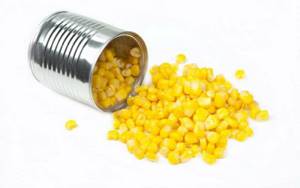
The benefits and harms of canned corn, how many calories, recipes

Is Hematogen a tasty treat or a medicine?

What kind of spelled cereal is this, properties, benefits and harm to the body
Pickled
Pickling significantly affects the calorie content of oyster mushrooms: depending on the recipe used and the additional components included in it, this indicator can either decrease to 23 kcal/100 g or increase to 126 kcal/100 g. The lowest-calorie pickled preparations, in addition to the main ingredient, contain: It contains only salt, vinegar and spices. And the highest calorie content is found in products with added sugar and vegetable oil.
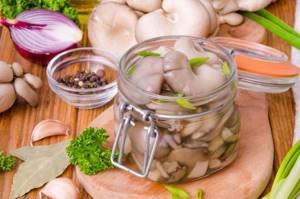
Regular, proper inclusion of pickled oyster mushrooms in the diet will contribute to:
- gradual weight loss by reducing caloric intake;
- reducing the risk of the development of pathogens in the intestines due to the bactericidal properties of mushroom juice, as well as improving the intestinal microflora under the influence of enzymes formed during the pickling process;
- normalization of pressure in the presence of hypertension or hypotension;
- normalization of “bad” cholesterol levels and prevention of atherosclerosis;
- removal of radioactive substances from the body.
The great advantage of all edible representatives of the oyster mushroom family is that during heat treatment they practically do not lose their beneficial properties. If after pickling the calorie content of oyster mushrooms is reduced by 2 times, then the nutritional value is reduced by only 5%. This product is an excellent independent snack and can be added to a wide variety of soups, salads, appetizers, vegetable stews, etc.
Important! When choosing pickled oyster mushrooms, you should take into account that only light-colored mushrooms without inclusions in pure transparent brine with a natural composition will be most useful. To visually assess the quality, you need to purchase the product in glass containers and preferably of domestic production.
It should also be taken into account that pickled mushrooms can cause heaviness in the stomach, diarrhea and allergic reactions. They are contraindicated if there is a tendency to swelling, disorders of the pancreas, kidneys, liver and gastrointestinal tract.
Compound
Oyster mushrooms include vitamins C, B, and protein. Their texture is soft and delicate. Mushrooms contain mineral salts. In terms of calcium, phosphorus, and iron content, they are even ahead of beef, pork, and chicken. There is 10 times more vitamin B3 than in vegetables.
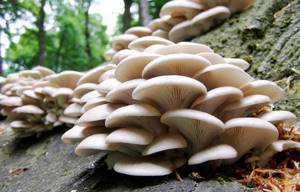
The product contains riboflavin, vitamin B3, B5, thiamine. It is rich in copper and potassium, minerals the body needs to distribute energy.
Dishes
Edible representatives of the oyster mushroom family are widely used in cooking, perfectly replacing more expensive and hard-to-find varieties of mushrooms. For regular, non-dietary eating, they are most often fried in oil. But when losing weight, in order to reduce the calorie content of oyster mushrooms in their finished form, it is recommended to use cooking and stewing. In many cuisines, they are used in dried form to give dishes new beneficial qualities and a special taste. It should be borne in mind that the aroma of oyster mushrooms is best combined with meat, game, potatoes, cereals and vegetables, but is completely unsuitable for adding to fish.
Boiled
The calorie content of boiled oyster mushrooms is slightly higher compared to fresh ones and amounts to 50 kcal/100 g. This is due to the fact that during heat treatment in water, the pulp is slightly boiled down and the content of all macronutrients and calories in it increases, respectively.

For boiling, prepared mushroom pulp, cut into small pieces, is placed in cold water, heated to a boil, and boiled for 5 minutes. It is then removed from the water and used in various recipes for cooking.
Thanks to short heat treatment, boiled mushrooms almost completely retain their original calorie content and 95% of their beneficial properties. This makes them an excellent component of most weight loss and overall health diets.
Fried
Unlike dietary boiled ones, the calorie content of fried oyster mushrooms increases almost 2 times - up to 76 kcal/100 g. The reason is simple: mushroom pulp is rich in fiber, which instantly absorbs heated oil. Therefore, after frying, this initially healthy dietary product loses its basic, valuable properties for weight loss.

To prepare, 1.5 kg of mushroom pulp, cut into medium pieces, is placed in a hot frying pan with sunflower or olive oil. Fry for 15 minutes over low heat, then add 300 g of finely chopped onions and fry for another 5 minutes. Used both hot and chilled.
Important! The calorie content of fried oyster mushrooms is significantly higher compared to other methods of preparing this product. Therefore, during the period of following a low-calorie diet, such a recipe should be abandoned.
To get a dietary version of this dish, as well as to reduce the harmful effects of chitin, it is recommended to first boil the pieces of mushroom pulp and then fry them in a minimum amount of oil. Boiled mushroom fiber will not absorb the fatty component, so the calorie content of oyster mushrooms in this case will be 53–55 kcal/100 g.
Stewed
Oyster mushrooms are stewed in different ways, but those that are pre-boiled and prepared without adding high-calorie components have the most pronounced beneficial properties and low calorie content.
Classic
In accordance with the classic recipe for such a dish, 1.5 kg of fresh oyster mushrooms are cut into pieces, boiled, mixed with 100 g of grated carrots and 100 g of finely chopped onion. Salt and pepper to taste. Simmer for 15 minutes, adding a little water if necessary. 100 grams of this dish contains only 29 kcal.

The calorie content of oyster mushrooms stewed in the same way, but with the addition of sour cream, depends on the selected fat content of this component. So, for the specified amount of products take 100 g of sour cream, which contains the following number of calories:
- fat content 10% (low-fat) - 115 kcal;
- 15% (low fat) - 158 kcal;
- 20% (medium fat content) - 206 kcal;
- 25% (classic) - 248 kcal.
Thus, when adding sour cream with 10% fat content, the total energy value will increase to 40.5 kcal/100 g, 15% - 44.8 kcal/100 g, 20% - 49.6 kcal/100 g, 25% - 53. 8 kcal/100 g, respectively.
With buckwheat
A very healthy dish is obtained from a combination of two low-calorie dietary components - oyster mushrooms and buckwheat. But since the recipe involves adding a small amount of sunflower oil and low-fat sour cream, the total energy value of the finished dish is 85.7 kcal/100 g.

To prepare, cut 500 g of mushroom caps into arbitrary pieces and place in a saucepan with vegetable oil (1 tbsp), which is preheated for 1 minute with spices to taste. Sauté for 2 minutes, then add 30 g of finely chopped fresh dill, pour in 100 ml of water and simmer for 20 minutes. At the end of cooking, add 3 tbsp. l. sour cream 15% fat, simmer for a couple more minutes. Separately, boil 400 g of buckwheat in 800 ml of water. Mix the finished buckwheat with the mushroom mixture, lightly steam it and turn off the heat. It turns out to be a very juicy, tasty, healthy and quite nutritious dish. If you need to reduce its calorie content, then sour cream is replaced with low-fat natural yogurt.
soup
Aromatic and light mushroom soup is cooked with oyster mushrooms - both lean and based on chicken broth. The total calorie content of the dish depends on the presence of meat in such a soup. So, 100 grams of the meat version of mushroom soup will contain 69 kcal, and the vegetarian version will contain only 48 kcal.

To prepare a healthy low-calorie dish, add 600 g of diced potatoes to 2 liters of boiling liquid and leave to simmer over low heat. At this time, 300 g of mushroom pulp, cut into small cubes, is stewed in a frying pan with the addition of 30 g of butter for 2-3 minutes, a finely chopped onion is added and fried over medium heat until the juice has completely evaporated and the onion-mushroom mixture is slightly browned. After this, it is added to the soup, salted and spices are added to taste. Bring to a boil, before turning off add finely chopped parsley, let it boil and remove from heat. Before use, let it brew for 15–20 minutes.
Storage
Mushrooms are a perishable product, including oyster mushrooms. Good ventilation is important for them. Products should not be sealed in a plastic bag. They are placed in the refrigerator at a temperature of -2 degrees. Under these storage conditions, mushrooms retain their taste and aroma.
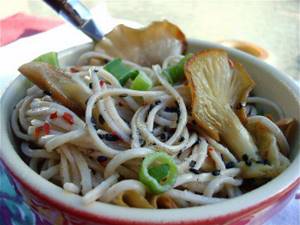
It is best to store oyster mushrooms in the freezer. This preserves their taste. Freezing extends the shelf life to 4 months. If you boil them before freezing, the product can be placed in the freezer for six months. Canned products can be stored for up to 1 year, but in a cool place. In the store, you need to choose only high-quality oyster mushrooms that do not have dark spots, mucus or an unpleasant odor.
The nutritional value
The uniqueness of oyster mushrooms lies in the fact that it contains almost all the substances necessary for humans - vitamins, minerals, proteins, fats, carbohydrates. At the same time, it has a low calorie content, but can satisfy hunger even with a small portion, which makes dishes made from it a very useful and even indispensable component of low-calorie diets. Their use not only allows you to avoid debilitating feelings of hunger and prevent breakdowns, but also saturates the blood with valuable elements, making the diet less stressful for the body.
Proteins fats carbohydrates
The amount of BJU in 100 grams of fresh oyster mushroom with a calorie value of 43 kcal is in the following ratio:
- proteins - 3.3 g (13 kcal);
- fat - 0.4 g (4 kcal), of which 0.02 g saturated fatty acids;
- carbohydrates - 4.2 g (17 kcal), including 1.11 g of mono- and disaccharides, 2.3 g of dietary fiber.
In 100 g of boiled oyster mushrooms with a calorie content of 50 kcal, the BJU content increases slightly:
- proteins - 3.4 g;
- fat - 0.42 g;
- carbohydrates - 6.18 g.
In 100 g of dried oyster mushrooms with a calorie content of 327 kcal, the amount and ratio of BZHU is completely different:
- proteins - 34.0 g;
- fat - 0.5 g;
- carbohydrates - 6.0 g.
100 g of pickled oyster mushrooms with a calorie content of 23 kcal contains:
- proteins - 1.0 g (4 kcal);
- fat - 1.5 g (14 kcal);
- carbohydrates - 0 g.
100 g of fried oyster mushrooms with a calorie content of 76 kcal contains:
- proteins - 2.28 g;
- fat – 4.43 g;
- carbohydrates - 6.97 g.
100 g of stewed oyster mushrooms contain 29 kcal calories (without sour cream):
- proteins - 1.29 g;
- fat – 1.1 g;
- carbohydrates – 3.6 g.
Like all mushrooms, representatives of the oyster mushroom family are sources of vegetable protein, the content of which is close to that of vegetable crops, but exceeds them in the amount of healthy fats and complex carbohydrates. Due to the presence of proteins and a significant portion of the amino acids necessary for humans, oyster mushroom dishes help accelerate recovery processes, strengthen the immune system and normal exercise tolerance.
Macro- and microelements
The biochemical composition of the oyster mushroom family is replete with minerals and valuable substances that play a significant role in maintaining the normal functioning of the body. The fiber they contain is an important, often underestimated, beneficial component of a healthy diet, but it may best prevent the hunger pangs that come with a low-calorie diet. The classic human diet is usually poor in fiber, and one serving of oyster mushrooms is enough to satisfy one third of the daily requirement. Therefore, such dishes saturate well, even with minimal calorie content.
According to American scientists, oyster mushrooms can replace many animal and plant sources of micro- and macroelements, in particular phosphorus, zinc, potassium, and iron. These and other beneficial substances have a number of positive effects on health:
- potassium - present in any intracellular fluid, ensures the normal functioning of soft tissues (vessels, endocrine glands, muscles, etc.), participates in the regulation of water balance, normalizes heart rhythm, promotes the conduction of nerve impulses, supports the functions of magnesium;
- magnesium - ensures the effective functioning of nerves and muscles, participates in the conversion of glucose into energy, prevents the formation of calcium deposits, prevents the formation of stones in the gall bladder and kidneys, normalizes the activity of the cardiac, vascular and endocrine systems;
- zinc - activates many enzymatic reactions, normalizes the processes of growth and puberty, supports the immune system, promotes protein synthesis, improves prostate function in men and the production of male sex hormones;
- iron is an important component of hemoglobin, responsible for the capture and transport of oxygen by red blood cells to all internal organs, ensures respiratory processes in cells, helps the immune system resist aggressive environmental influences;
- phosphorus is one of the main useful elements of DNA and RNA, participates in the transport of energy, regulates hormones, normalizes digestion, liver and brain function;
- selenium - increases immunity, reduces the risk of developing malignant and benign tumors, stimulates metabolic processes, activates the formation of red blood cells and proteins, and prevents the formation of free radicals;
- manganese - improves cell development, promotes the absorption of iron, copper and vitamins, ensuring hematopoiesis, cell development and bone structure formation;
- copper - participates in the formation of enzymes and proteins, accumulates in the blood, brain, liver, kidneys, muscle and bone tissue, therefore, if it is deficient, the functioning of these vital organs is disrupted;
- sodium - improves water-salt metabolism, improves the functions of the salivary and pancreas, activates the production of gastric juice, maintains the osmotic concentration of the blood;
- Calcium has a beneficial effect on teeth and bones, is directly involved in the process of excitability of nerves and contractility of muscle tissue, and normalizes blood clotting.
Oyster mushrooms are also rich in enzymes that are useful for weight loss, promoting the breakdown of lipids and glycogen. In addition, with regular consumption of such a product, the level of “bad” cholesterol is reduced and the development of E. coli is suppressed.
Vitamins
In terms of the set of vitamins, oyster mushroom is similar to meat, and in terms of the content of some of them it is considered the most useful mushroom. The main value in the composition are the following vitamins:
- B1 - necessary for maintaining the proper functioning of the heart, nervous system and digestion, helps with skin lesions of a nervous nature, increases brain activity and mental abilities, eliminates depression and other mental illnesses;
- B2 - participates in tissue respiration, promotes energy production, normalizes the reproduction of stress hormones during constant nervous overload, protects the nervous system as a whole;
- B3 (PP) - controls a number of biochemical processes, participates in the formation of enzymes for cellular respiration, stimulates the metabolism of fats, proteins and carbohydrates, improves brain function, and ensures full vision;
- B4 - prevents central nervous system disorders, is a hepatoprotector, prevents the development of cholelithiasis, eliminates the effects of harmful effects on tissues of toxins of alcohol, drugs and medications;
- B5 - participates in lipid metabolism, cell development and renewal, production of hormones by the adrenal glands, formation of red blood cells and amino acids, accelerates wound healing, increases the absorption of other vitamins, and directly affects the condition of hair;
- B6 - prevents nervous disorders and skin diseases on this basis, normalizes the synthesis of nucleic acids, relieves nighttime muscle spasms, cramps, numbness and neuritis of the extremities, produces a diuretic effect;
- B9 - “vitamin of good mood”, promotes the production of “happiness” hormones, supplies carbon for the production of hemoglobin, accelerates cell division and the development of all tissues, maintains a healthy heart and blood vessels, has a beneficial effect on hematopoiesis and the functionality of leukocytes (“combat” units of immunity ), strengthens the health of the liver and digestive system as a whole;
- A - antioxidant, an active participant in redox reactions and protein synthesis processes, normalizes metabolism and the functions of cell membranes, strengthens bones and teeth, helps maintain vision, slows down aging;
- beta carotene is a powerful immunomodulator and supplier of vitamin A, into which it is converted under the influence of certain enzymes in the body - from 1 molecule of beta carotene 2 molecules of vitamin A are obtained.
In the human body, under the influence of unfavorable environmental conditions or infections and lymphocytes fighting them, free radicals are constantly formed. An excess of these harmful compounds poses a great danger to human health, since they destroy cells and lead to accelerated aging of the body. To protect against free radicals, antioxidants are used, which are synthesized by the body, but not always in sufficient quantities, so they must come from food. Oyster mushroom is considered one of the richest sources of such beneficial substances. Regular consumption of such mushrooms, even in moderate quantities, helps strengthen the immune defense, increase the effectiveness of the fight against infectious agents and adverse environmental influences, as well as stress and its consequences.
In general, excellent taste, versatility in culinary processing, rich vitamin and mineral composition, maximum beneficial properties, minimum contraindications and low calorie content of oyster mushroom make it an indispensable component of both regular and many dietary diets. Dishes made from it are widely used during periods of weight loss or recovery, as well as in daily nutrition and in holiday menus. The main thing is that oyster mushrooms are consumed in moderation and always after careful heat treatment. There is simply no other way to eat these mushrooms.
Calorie content of boiled oyster mushrooms per 100 grams
The calorie content of boiled oyster mushrooms per 100 grams is 34.8 kcal. In 100 g of such mushrooms:
- 3.4 g protein;
- 0.42 g fat;
- 6.18 g carbohydrates.
Read: Boletus calorie content per 100 grams
Boiled oyster mushrooms retain most of their beneficial properties with short heat treatment. Due to their low fat content and calorie content, such mushrooms can be included in the diet in almost any health diet.
Beneficial properties for the human body
Oyster mushrooms are included in the list of a few products that, when consumed in moderation, can have a therapeutic effect on the body. This is explained by the special ratio of important vitamins and minerals, which make it possible to reduce the activity of pathological processes in organs and tissues, as well as the content of all kinds of toxins.
Lowering cholesterol and avoiding atherosclerosis
Most people over the age of 40 face the problem of cholesterol. Poor nutrition and all kinds of metabolic and endocrine diseases lead to the fact that fat metabolism in the body is disrupted, and insoluble lipid compounds gradually accumulate in the vessels. Over time, this leads to disruption of the elasticity of blood vessels and their muscle layer, after which, of course, chronic atherosclerosis occurs.
Description
Oyster mushroom is a typical representative of the Oyster family, the genus of the same name. This is one of the most popular industrial mushrooms, which can be successfully grown in your own garden bed, with a minimum set of specific skills. In its natural environment, the species can be found in forests of the temperate zone, in small groups. This is a saprophytic organism; the main substrate for its growth is all kinds of woody debris.
This mushroom is quite large and massive, the average diameter of the hat is in the range of 5–15 cm, with a maximum mark of 30 cm. It is often solid, round, but there are also hybrids with an ear-shaped and shell-like shape. The color of the cap's skin is uniform; as it grows, the shade can change from light gray to brown. The hymenophore in this species is lamellar. The plates are located quite rarely, up to 15 mm thick. In actively growing specimens, the color of the plates is white, but as the fruiting body ages, it changes to yellowish or gray tones.
Unlike the hat, the leg is quite thin and short, up to 5 cm long. At the same time, it is distinguished by dense and elastic flesh, covered with soft white skin. At the base of the leg, the shade can change to light brown tones.
For children
The products are safe for children compared to other vegetables that may contain harmful bacteria. If prepared and stored correctly, they can be consumed regularly. You just need to choose the appropriate cooking method. Before doing this, it is advisable to treat the mushrooms with boiling water.

Oyster mushrooms contain protein, so it is better to combine them with boiled or stewed vegetables. They make excellent stews, casseroles, and sauces. The dishes will be satisfying and low-calorie. Just don't use them at night. It is not recommended to eat them more than three times a week to avoid addiction.

